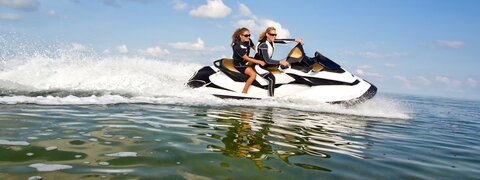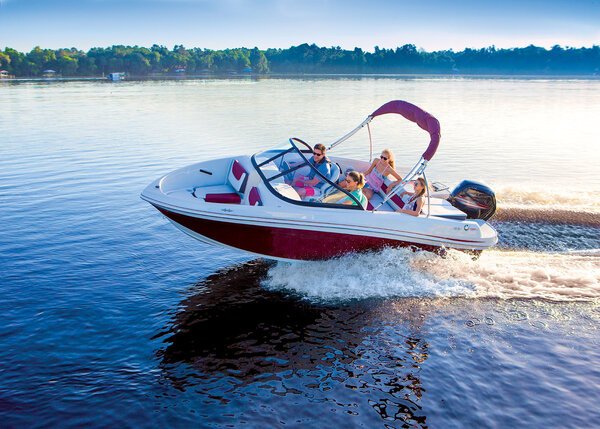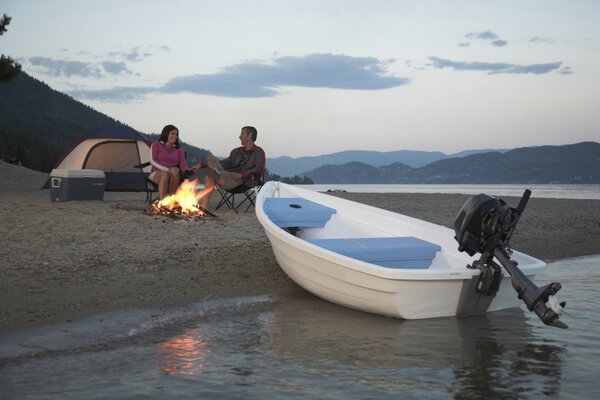Personal watercrafts (PWCs) are easy to own and a thrill to ride, and offer a boating experience that puts you close to the water. Quick and agile, a personal watercraft is powered by a water jet and performs like a motorcycle on the water.
A personal watercraft trailer can tow one to four PWC behind a modest tow vehicle. A PWC offers an affordable way to get into boating, or to add a second boat for a different kind of fun, and the cost stays low because a PWC is easy on fuel and does not require much maintenance.

Explore Boat Brands
Personal Watercraft
Use our Boat Loan Calculator to get a better idea of your own budget.
Looking for a different boat?
Activities with Personal Watercraft (PWC)
GREAT FOR Day Cruising • Watersports
Personal watercraft owners have discovered they can enjoy almost any boating activity, except perhaps sleeping on board. A PWC can be used to day cruise or even tour over long distances. Many PWC have enough power to tow a wakeboarder or a tube. Because they draw very little water, a PWC can maneuver an angler into the shallows, and with accessories can be set up to be a very capable fishing craft.
A PWC is easy to tow and launch, without an expensive heavy-duty tow vehicle, so one is perfect for boaters who like to roam and explore new waterways. Feeling competitive? There are active national and regional race series for personal watercraft.
Ownership Costs of Personal Watercraft (PWC)
Personal watercraft prices range from less than $5,500 for compact, two-passenger “rec-lite” models to more than $17,000 for the most powerful, luxurious and feature-laden three-passenger models. Most owners use a PWC trailer for off-season storage and moving the craft to and from the water, and the trailer is sold separately from the craft; expect to pay about $500 for a basic single-craft trailer to $3,500 for a trailer that can carry three PWC.
When considering PWC price don't forget the basic items you'll need to get out on the water, including dock lines, life jackets and other safety gear required in your state.
PWCs are quite affordable, but to be sure if they fit within your unique budget, use our Boat Loan Calculator.
Maintenance Costs
Maintenance costs are certainly a factor every potential boat owner needs to consider in advance. Compared to boats, PWC require minimal maintenance; an annual oil change and off-season storage prep for most owners. PWC are self-draining so do not require an extensive off-season storage procedure. Be sure to check out the Maintenance pages in our Owning a Boat section, which will give you an idea of what’s involved. Most aluminum fishing boats will be powered by an outboard motor.
Operation Costs
As with any boat, the key operation cost for any PWC is going to be fuel, and that cost will be influenced by how you use the craft and its size and power. A more-powerful PWC will naturally use more fuel, and if you enjoy hard acceleration and faster speed, you’ll also use more fuel. Many PWC now have an “eco” mode that electronically reduces performance and can dramatically improve fuel economy. Other operational costs include annual registration and insurance, trailer registration if required in your state, and off-season storage if you can’t or don’t care to store the craft at home.
Check your state regulations for information on who is required to have a boater or PWC license. Owners who live on the water might consider investing in a PWC lift or docking ramp that stores the boat out of the water but also makes it easy to launch when it’s time to ride. Speaking of trailers, before making a purchase make sure your vehicle has a tow rating that can handle the weight of the boat and trailer you are considering.
Personal Watercraft Technology/Materials/Features
Personal watercraft are offered in two basic styles: sit-down and stand-up models. Sit-down models have a seat for one to three passengers. Stand-up models have no seat and represent the origins of the sport, which was really kick-started in the 1970s. Those original stand-up models required a lot of athletic ability to ride well, but today’s stand-up models are wider and longer and much easier to ride. It’s still more challenging than a sit-down PWC, and for some riders much more entertaining just because it’s a bit of a challenge.
Sit-down models range from “rec-lite” models with seating for two, a 90-horsepower engine and a top speed of 45 mph to three-passenger luxury models with 300 horsepower and a top speed approaching 70 mph. The most-deluxe models may feature a deep-bolstered touring seat, GPS-based navigation, an audio system and electronic cruise control and speed controls that make it easier to tow tubers and skiers. Some models come equipped specifically for tow sports, with a towing pylon and accommodations for a rear-facing “observer” passenger. Others are rigged for anglers, with rod holders and a fishfinder.
All current personal watercraft engines are smooth-and-quiet four-stroke motors, which drive a jet pump that propels the craft with a high-pressure jet of water instead of the propeller. Because the jet outlet is above the bottom of the hull, a PWC may draw just inches of water at speed, so it’s able to zip over shallows, and is easy to beach.
The most-powerful, high-performance PWC models are capable of lightning-quick acceleration and top speeds exceeding 65 mph – performance that demands respect from the rider and requires awareness on the water. These models may not be a good choice for beginning or younger riders. Many have a “learning mode” that dials back the performance.
The best personal watercraft is one that fits the way you want to ride—short, quick blasts around the lake, towing tubers all afternoon, angling and exploring or long-distance touring. There’s a PWC model equipped for any activity.


